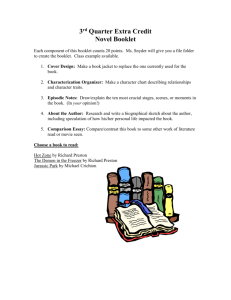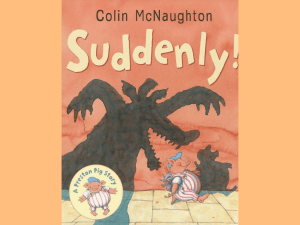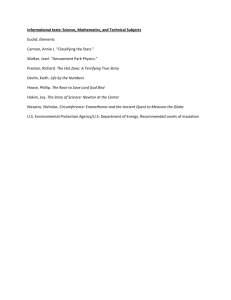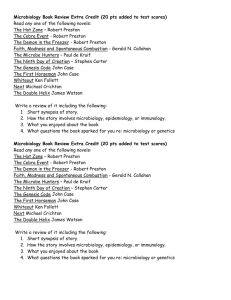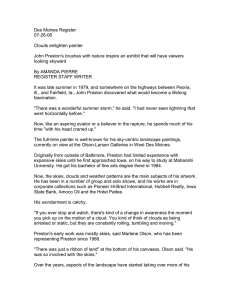COMPETITIVE GRANT APPLICATION Core Subject Integration Innovation Zone Designation
advertisement
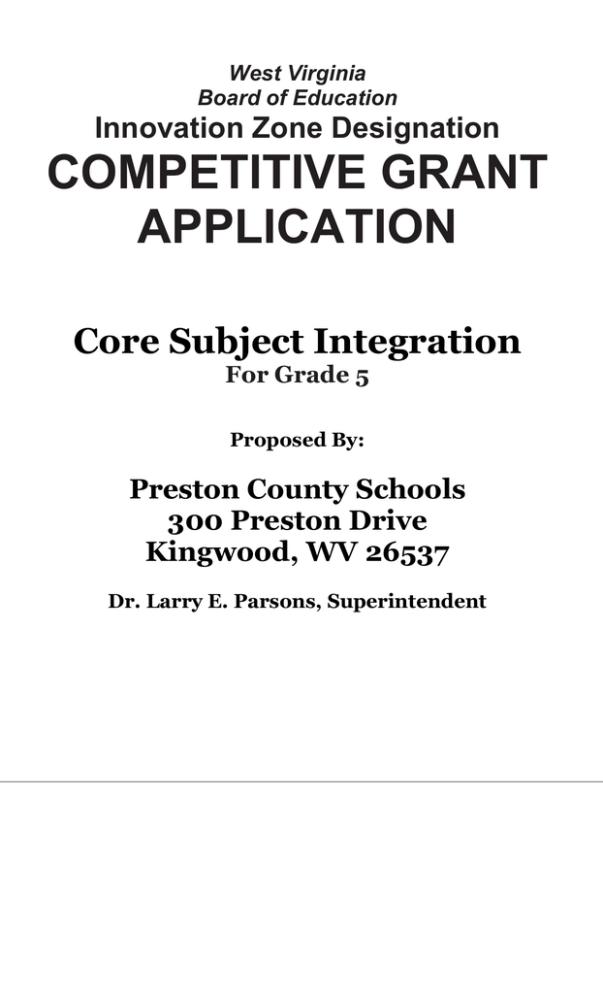
West Virginia Board of Education Innovation Zone Designation COMPETITIVE GRANT APPLICATION Core Subject Integration For Grade 5 Proposed By: Preston County Schools 300 Preston Drive Kingwood, WV 26537 Dr. Larry E. Parsons, Superintendent B. Information of Applicant: Entity Applying for Innovation Zone Designation __________ A school __________ One or more schools acting as a consortia _____X____ A group of schools seeking designation across the same subdivision or department of the schools __________ A school seeking designation of a subdivision or department __________ A higher education institution Name of Entity Applying: Grade 5 at Kingwood, Terra Alta, and Bruceton Schools County: Preston Superintendent: Dr. Larry Parsons Number of Professional Personnel: 8 Teachers, 3 Principals, 3 Central Office Staff Number of Service Personnel: N/A Institution of Higher Education: WVU as a continuing partner in Professional Learning Communities County Location: RESA VII C. Narratives for the Innovation Zone Application: Preston County seeks a $25,250 Innovation Zone Planning Grant from the West Virginia Department of Education to implement the curriculum integration of Math and Science and the integration of Social Studies and Language Arts. This integration will occur at the 5th grade level in 3 of the 8 elementary schools with the intent to extend the pilot to all elementary schools and to 4th grade. The project is also expected to have significance to the Race To The Top (RTTT) initiative. The needs in Preston County that have led to seeking this planning grant are based upon the WESTEST II Math and Reading scores declined from WESTEST scores. WESTEST II better reflects skills necessary to succeed in the 21st Century. WESTEST II skills emphasize the need for rigor and relationships in the curriculum delivered to students. This integrated approach better mirrors those skills than the traditional isolated subject approach. The Office of Education and Performance Audits (OEPA) report on Preston County notes that they did not see evidence of hands-on science occurring at Kingwood Elementary. This integrated approach will better address this need. Preston County is currently exploring an initiative in Project Based Learning (PBL) at the secondary level. Students who have the experience at the 5th grade level with these integrated courses will be better prepared to achieve success with PBL as they advance in school. Teachers have already received on-going training on Professional Learning Communities (PLCs), and the fifth grade teachers who participate in this initiative will have the integrated curriculum as the focus of their PLC. Finally, teachers often comment on the issue of having the time to devote to these four core content areas, which often means that science and social studies tend to get shortchanged in terms of preparation time. The integration approach will allow teachers to more efficiently emphasize the four curriculum areas both time wise and content wise. The overall goal of the Planning Grant is to provide 200 Preston County 5th grade students a high quality, interactive, and integrated experience in the core curriculum areas of Math and Science and in Social Studies and Language Arts. To accomplish this goal, 5th grade teachers at participating elementary schools will form a Professional Learning Community focused on working towards being ready to offer the integrated courses beginning in fall 2010. Two core leadership teams, one in Math and Science and one in Social Studies and Language Arts, will upon receipt of the planning grants meet as a team 4 afternoons before school is out to plan the end-of-school work sessions. Planning Grant resources will be used to fund substitutes to allow for this release time for the teachers. They will also be the integral part of the planning team for a two-week summer work session for the initiative. All participating 5th grade teachers will attend the summer session to be scheduled right after the close of schools for the academic year. One week will be dedicated to Mathematics and Science. The other week will focus on Language Arts and Social Studies. These meetings will begin with unpacking the standards to determine those standards that can best be met via the integrated approach and those standards that still need to be emphasized in the more traditional subject matter approach. They will receive the professional development needed to enable them to prepare for the change from the subject by subject to the integrated approach. Time will be allotted to design units and lesson plans. The bulk of the award will fund the teacher stipends and a part-time facilitator for this two-week work session. Principals and other leadership personnel from the participating elementary schools will provide support in accomplishing the goals. They will be a part of the evaluation of the planning grant by conducting walkthroughs of those integrated classrooms, helping to inform and engage the parents and communities with this transition, and providing the substitutes and time for planning activities. Central office staff, particularly those administering Title I and Title II funds, will be an important resource in administering the project and using federal resources to supplement the planning grant funds. Potential partners in the project include the West Virginia Department of Education, West Virginia University, RESA VII, Preston County Central Office, and Preston County parents and businesses. These partners have already been involved in Preston County’s education agenda by such contributions as providing district wide training in PLCs and professional development in unpacking the Content Standards and Objectives. Action Steps Timeframe Meet 4 half school days to plan to plan Meet to plan Language Arts and Social Studies integrated lessons Meet to plan Mathematics and Science integrated lessons February and March 2010 School teams meet 4 hours monthly as PLC August 2010 – May 2011 June 14 – 18, 2010 June 21 – 25, 2010 PLAN OF WORK Resources Responsible Person(s) Innovation Zone Teddi Cox and Preston County Mark Graham Administrators Innovation Zone Teddi Cox, Mark Preston County Graham. Administrators Contracted facilitator for 2 days Innovation Zone Teddi Cox, Mark Preston County Graham. Administrators Contracted facilitator for 2 days Innovation Zone Teddi Cox Preston County Administrators Measurement Of Progress Agendas, minutes, and plan Agendas, minutes, and unit & lesson plans Agendas, minutes, and unit & lesson plans Agendas, minutes, online portal Research Base: By and large, both in public and independent school education, there is still a tendency to focus on the disciplines separately, and frankly, there’s a lot of value in that. There’s great value in going deeply into a subject and learning the tools and the approaches that are used by specialists in those areas, but in practice, there’s almost no profession in the world of work where there aren’t integrated perspectives. Unfortunately, most twenty-first century public schools in the United States are structured pretty much the same as they were in the nineteenth century. And yet real life in the twenty-first century has undergone dramatic changes. Changes include a shift from an agricultural and industrial economy where the majority of people lived in rural settings to a hyper fast, dynamic global society centered on the development and exchange of knowledge and information in a multiplicity of forms. In our past, the expectation was that an individual would master a certain trade or skill and work in that field for the rest of his or her career. Today, in the information economy, fluency in several disciplines and the ability to move comfortably among them, being capable of distilling meaning from complexity, and seeing connections where they may not be apparent on the surface are critical skills for success. The theme of the West Virginia Department’s Innovation Zones, created by the School Innovation Zones Act, is to educate, collaborate, and create. In alignment with this thinking is the fact that the integrated approach to core disciplines is also focused on creativity, adaptability, critical reasoning, and collaboration – those marketable skills that allow K-12 education institutions to keep pace with the seismic shift in our society. In a research report titled The Logic of Interdisciplinary Studies by Sandra Mathison and Melissa Freeman that was presented at the annual meeting of the American Educational Research Association in 1997, the authors wrote, “Interdisciplinary, integrated and integrative studies represent an opportunity to have more meaningful relations with students; teach cognitive skills associated with ‘real life’ (e.g., cooperation, problem solving, ability to see connections); motivate students; increase student achievement; promote positive attitude toward subject matter; create more curricular flexibility; diminish scheduling problems; and integrate new and rapidly changing information with increased time efficiency.” The research report found broad consensus among dozens of researchers as to what the report called the “positive educational outcomes” for students in an integrated-studies program: • An increase in understanding, retention, and application of general concepts. • A better overall comprehension of global interdependencies, along with the development of multiple perspectives, points of view, and values. • An increase in the ability to make decisions, think critically and creatively, and synthesize knowledge beyond the disciplines. • The increased ability to identify, assess, and transfer significant information needed for solving novel problems. • The promotion of cooperative learning, a better attitude toward oneself as a learner and as a meaningful member of a community. • Increased motivation. Research also speaks to the need for the structure of twenty-first century public schools in the United States to reflect the dynamic global society centered on the development and exchange of knowledge and information in a multiplicity of forms. The integrated approach aligns much more closely to the ‘real life’ (e.g., cooperation, problem solving, ability to see connections) students will experience as they enter education experiences beyond high school and begin their careers. Fortunately, today many educators-from teachers to administrators-as well as policy makers feel the same way. Since the mid-1990s, in addition to Sir Ken Robinson and Heidi Hayes Jacobs, several key figures have stoked the discussion of integrated studies through their own work and influential books, including James Beane, author of Curriculum Integration: Designing the Core of Democratic Education; Julie Thompson Klien, author of Crossing Boundaries: Knowledge, Disciplinarities, and Interdisciplinarities and Mapping Interdisciplinary Studies; and Robin J. Fogarty, author of How to Integrate the Curricula and Integrating Curricula with Multiple Intelligences: Teams, Themes, and Threads (the latter coauthored with Judy Stoehr). Project Evaluation: When the cook tastes the soup, that’s formative; when the guests taste the soup, that’s summative. (Stake, as quoted in Stevens, Lawrenz & Sharp, 1993, p. 6) The evaluation described here will serve two overarching purposes: (a) to provide useful information by which to make programmatic adjustments, and (b) to collect, analyze, and present valid and reliable data on program goals, objectives, and outcomes. These two functions are essentially formative and summative evaluation. Evaluation is considered an integral element of program planning and implementation. Evaluation of the project is intended to be an ongoing process that not only assesses activities and accomplishments but also strives to determine the merit, or value, of accomplishments and then use this information for continuous improvement. The evaluation will serve the following functions, each with formative and summative components: • provide evidence of the quality and effectiveness of the project in meeting its stated objectives • document the quality and effectiveness of the basic strategies in developing a trajectory toward its long-term goal • examine how the structure and operation of the project itself (challenges, leadership, responsiveness, etc.) affect its success in implementing its strategies • collect and maintain data on an ongoing basis that will become the central component of the annual report submitted to the West Virginia Board of Education Evaluation Design Just as a stool is more solid if it rests on three legs rather than one or two, information collected will be more solid if it is collected from more than one source, at more than one point in time, in a number of different ways. (Branigan, 2002) The evaluation of the project will be a critical component of the planning grant. The evaluation will focus both on results and processes. The School Innovation Zones Act requires that each grantee submits an annual report regarding the progress related to the project design to the West Virginia Board of Education. Principals, other school leaders, and teachers have received professional development and have designed and conducted several hundred walkthroughs. They will customize the walkthroughs with help from the Central Office Title I and Title II staff to evaluate the Planning Grant. Walkthrough data will be gathered, analyzed, and reported. In addition the Technology staff will design an online portal to house artifacts such as agendas, meeting notes, research articles, and PLC activities. These artifacts will also be part of the evaluation. Two administrators involved in this project are participating in the Classroom Assessment Network II (CAN II) and will provide leadership in formative evaluation procedures. Formative assessment will provide on-going feedback as to the attainment of the goals for student performance. Surveys of participating teachers, school leadership, students, partners, and parents will also be developed and administered with resulting data analyzed and presented as part of the annual report. The Preston County Title I and Elementary Education Director will manage the project. A Technology Integration Specialist will participate in the four afternoon and summer sessions. The Technology Integration Specialist will design the online portal to house artifacts, such as meeting agendas and notes; research-based articles; and other PLC data. Table 1: Project Performance Objectives, Evaluation Questions, Evaluation Methods Performance Objectives OBJECTIVE 1: To form a core leadership team of 5th grade teachers to plan integration of math and science Objective 2: To form a core leadership team of 5th grade teachers to plan integration of social studies and language arts Objective 3: To plan and conduct a 2 week summer work session to be held in June, 2010 Evaluation Questions Evaluation Methods Notes 1a. Was the core leadership team formed? Focus group interview data 1b. Did the core leadership team review content standards of math and science and determine those that could be met through an integrated approach? Document and artifact review The electronic portal will be used to house artifacts such as agenda and minutes of meetings. 1.c. Did the core leadership core team function as a Professional Learning Community? 2.a. Was the core leadership team formed? 2.b. Did the core leadership team review content standards of math and science and determine those that could be met through an integrated approach? 2.c. Did the core leadership team function as a Professional Learning Community? 3.a. Was the summer institute planned for participating 5th grade teachers? Survey of participating teachers Focus group interview data from interview Document and artifact review Survey of participating teachers Focus group with each planning team Survey/Focus group with institute participants 3.b. Was the summer institute conducted for participating 5th grade teachers? Agenda, copy of materials used in the summer 3.c. Were integrated courses ready to begin in fall of 2010? Course review of integrated courses in math & science and in social studies & language arts These items will also become part of the evaluation data. The electronic portal will be used to house artifacts such as agenda and minutes of meetings. These items will also become part of the evaluation data. The electronic portal will be used to house artifacts such as agenda and minutes of meetings. These items will also become part of the evaluation data. The project is viewed as a pilot project that once successfully planned, implemented, and documented will create interest and promote articulation at, for example, the fourth and sixth grade levels. The core leadership teams will be able to conduct train-the-trainers sessions for other interested schools and be a support system as other schools integrate curriculum. Beyond the district, the same train-the trainers approach could be used to scale curriculum integration on a statewide level with the support of the West Virginia Department of Education. Plans also include sustaining this capacity for integrated curriculum beyond the initial funding period through the use of federal funds focused on PLCs such as Title I and Title II. Management Capabililty: Preston County considers the receipt of this planning grant as a contractual agreement. As such, the necessary resources will be committed to ensure the adherence to the plan as defined in the design section of this proposal. Central Office staff is identified to manage the project. Principals and teachers at participating schools have made formal commitments to the project. The local Board and parents are also in support of the project. Dr. Teddi Cox, Title I Director and elementary supervisor, will be the Director. Dr. Cox will ensure that the goals and objectives as presented in the design section are achieved, and she will monitor and manage the approved budget. Dr. Cox designed an integrated program at Chattanooga School for the Arts and Sciences, identified by the USDE as one of the six model magnet schools in the country. Mark Graham will serve as the Technology Integration Specialist (TIS) for the project. Mr. Graham will design and maintain the portal and the PLC electronic site. He designed and implemented an integrated program as a sixth grade teacher at Bruceton School. Teacher leader chairpersons will be designated for each of the leadership teams, and each of those individuals will devote approximately 2 hours per week to the project. Time over and beyond their normal teaching load will be compensated and that has been built into the budget. These two teacher leaders will work closely with the Central Office staff. Scalability and Sustainability: The success of Preston County’s project will be used to promote articulation of the concept at the 4th grade level and 6th grade level within the district. Teacher leaders will conduct train-the-trainer sessions with interested schools to enable them to benefit from the experience of the project participants. Core team members, school principals, and district Title I and Title II staff will submit proposals to appropriate state meetings, such as the annual Title I and/or Title II Director conferences, to present informative, hands-on sessions for other schools and districts interested in pursuing an integrated curriculum approach. A professional learning community’s electronic site will be used to house a chronology of establishing integrated core subject experiences. The electronic portal will house agendas, meeting notes, research-based artifacts, and evaluation data, all of which can be used by new schools and districts interested in beginning such a process. Scalability on a statewide basis is certainly a potential by-product of the model that will have started as a Preston County Innovation Zone initiative. This would require support from the West Virginia Department of Education and other partners such as higher education, RESAs, and business/community entities. Sustaining the project beyond the initial funding period will occur through regular state and federal funding sources. After the initial planning and organization, the integration of subjects will be the choice of teachers. Preston County Schools will continue to seek funds to augment available PLC time. Seven of the 8 Preston County elementary schools are Title I schools, and Bruceton School, the only non-Title I elementary school, receives Title II support. These programs will continue to support the PLC model of professional development. Policies or Code that Prohibit or Constrain the Design: o _____Waiver Requested of County Policy: o _____Waiver Requested of WVBOE Policy or Regulation: o _____Waiver Requested of Statute: o __X__ N/A (No Waiver Requested) Policy 2510, Assuring the Quality of Education: Regulations for Education Programs states; These required core courses shall be taught daily by a team of qualified teachers. An intervention component will ensure mastery of the rigorous content standards and objectives at each grade level. The core courses (Reading and English/Language Arts, Mathematics/Algebra I, Science and Social Studies) will be offered within a block of time no less than 180 minutes. The principal and a team of teachers will determine time allocations that provide adequate time to achieve mastery of the West Virginia content standards and objectives for each of the required courses and effectively address the academic needs of students who are below mastery in the basic skills of reading, writing and mathematics. However, in reality teachers have planned instruction for each subject separately, using a different textbook. This project will provide time for teachers to plan for the core subjects using the Content Standards and Objectives as the organizer and guide instead of textbooks. Planning Narrative and Budget Page: Preston County is seeking funding to implement a project to integrate Mathematics and Science and Social Studies and Language Arts. The project will involve meetings to plan to plan during this school year, 2 week-long work sessions in June 2010, and monthly Professional Learning Community type meetings throughout the 2010-11 school year. The major expense of the project is for teacher stipends for planning, research, and record keeping. The actual implementation of the integrated curricula will be during regular school. Eight grade 5 teachers will form a PLC focused on integrating courses beginning in fall 2010. Two core leadership teams, one in Math and Science and one in Social Studies and Language Arts, will meet as a team 4 afternoons before school is out to plan the end-of-school work sessions. Planning Grant resources will be used to fund substitutes. The 5th grade teachers will attend the summer session to be scheduled in June. One week will focus on Mathematics and Science and the other week will focus on Language Arts and Social Studies. A contracted facilitator will lead the beginning of the first work session. Time will be allotted to design units and lesson plans. The teachers will then participate in monthly PLC meetings to share success and failures, discuss data from formative assessments, and collaborate on needs in instruction. A Technology Integration Specialist will provide assistance in reporting data and integrating technology. Two teacher leader chairpersons will devote approximately 2 hours per week to the project. Activity 4 half day “plan to plan” sessions for 8 teachers 1 week Mathematics and Science session Contracted Facilitator 1 week Language Arts and Social Studies session Monthly PLC sessions throughout the school year 2010-11 Technology integration by TIS 2 teacher leaders Project Director Resource Materials Function Substitute teachers Funding Source Innovation Zone Grant IZ Cost $2400.00 Teacher stipends Innovation Zone Grant $5ooo.00 On-site for minimum of 2 days at summer session plus prep time Teacher stipends Innovation Zone Grant $1500.00 Innovation Zone Grant $5000.00 Teacher stipends – 4 hr monthly for 9 mo. for 8 Stipend for project work beyond normal workday Help with data collection and reports Leadership and Communication Research and Organization Innovation Zone Grant $5760.00 Innovation Zone Grant $2690.00 Innovation Zone Grant $2400.00 Preston County $0 Preston County and Innovation Zone Grant TOTAL $500 $25,250.00 Supporting Documents: 1. Record of Staff Commitment 2. LEA Report of Support or Concerns 3. Verification of Support from: students, parents, school business partners, local school improvement council 22 December 2009 Dr. Teddi Cox 300 Preston Drive Kingwood, WV 26537 Dear Dr. Cox, Please accept this letter as an indication of support for the Preston County grade five teachers’ interested in using professional learning community (PLC) activities to address their goal of integrating math and science instruction and language arts and social studies instruction. West Virginia University, in collaboration with the Preston County Board of Education, has been working on a professional development initiative entitled “Preston County Deep Literacy Learning” (PCDLL). Our work together has focused on the investigation of ways to establish a practice of professional learning community (PLC) work focused on students’ writing performance and teachers’ writing instruction. This work has included analyzing available standardized and informal writing data specific to student performance and teachers instructional practices for the purpose of identifying areas of strength and of potential need for improvement at the county level, the school level, and the grade level. It has recently been brought to our attention that a number of the teachers currently responsible for the instruction of students in grade five have expressed interest in taking the PLC work being done as a part of the PCDLL initiative to a new depth. They plan to submit a proposal an Innovation Zone planning grant offered by the West Virginia Department of Education (WVDE). The grade five teachers’ interests focus on the integration of math and science instruction and the integration of language arts and social studies instruction. It is our understanding that these planning grant funds from will allow teachers to deconstruct the West Virginia Content Standards and Objectives in an effort toward organizing instructional units of study that integrate and meet the standards for grade five students. This collaborative work among grade five teachers will foster continual review of lesson designs to provide on-going best instructional practices and experiences geared toward identified needs of students. Again, please accept this letter as an indication of support of these grade five teachers’ interest in using professional learning community (PLC) activities to address their goals. Their growth in understanding of PLCs and in the use of PLCs to address specific issues during our PCDLL initiative demonstrate their ability to use PLCs to address this new initiative focused on the instructional integration of math and science and of language arts and social studies. Sincerely, Judy A. Abbott Judy A. Abbott, Ph.D., Assistant Dean & Associate Professor December 28, 2009 To whom it may concern, As a parent of a student at Bruceton School in Bruceton Mills, WV and as a sitting board member on the Preston County Literacy Volunteers, I'm writing a statement of support for integrating math and science as well as social studies with language arts in our schools. I feel it would make those subject matters more interesting for students and prepare my sons for life in the 21st century. Thank you, Sarah Scardina RRT 1, Box 106 Bruceton Mills, WV 26525 304-290-6589 Lena Antimonova Cerbone CNM 3801 North Preston Highway Albright, West Virginia 26519 h) 304-329-3120; email) lahmidwife@yahoo.com 29 December 2009 Dr. Teddi Cox Director of Elementary Education Preston County Schools Kingwood, West Virginia 26537 (via email to trcox@access.k12.wv.us) Dear Dr. Cox: I write in support of the pilot program to integrate Math and Science as well as Social Studies and Language Arts in three fifth grade classes in Preston County with a hope to extend to all fifth grades and then further into other grade levels. As a mother as well as the Chair of the Local School Improvement Committee (LSIC), I feel strongly that Preston County students should not be, in the catch phrase of the day, “left behind.” Also, as an educator myself (as you know, I am on faculty at the WVU School of Medicine) I agree totally with the goal of this integrative method of teaching: medical students and medical residents, though obviously very bright young people, often have difficulty putting together all their considerable knowledge in a way that can help them assess, diagnose, and then care for their patients. No matter how completely you understand any given subject, if you cannot apply your knowledge in practice it will do you no good. The first step in this synthesis is exactly the type of integrative thinking that your proposed program aims to teach. And the earlier those students can learn to let their brains put different kinds of thinking together the better. It can only serve them well in their future endeavors. Please let me know how this grant proposal works out: I look forward to hearing from Henry, Lowell, and Margot how they learned to do math in science class! All best wishes for a healthy and productive New Year. Sincerely yours, Lena Antimonova Cerbone CNM, MSN Chair, Kingwood Elementary LSIC Committee January 14, 2010 Dear Sir or Madam: It has come to our attention that the Preston County Title I Director, Dr. Teddi Cox, is submitting an application for extra funding in support of training for teachers over the summer to help support integration learning of Science with Math and Social Studies with Language Arts for 5th grade students. We as parents with boys of both 4th and 5th grade students highly support this application. We believe that both subjects of Science and Social Studies do not get an effective amount of attention during the school year and this integration will help with that attention while still maintaining the proper focus on the other subjects of Math and Language Arts. We also believe that this will help align the learning process closer to Secondary and higher levels of education. Multitasking and utilizing more than one talent at a time is critical in today’s work force and the earlier this begins the better. We also understand that this training is designed to help teachers integrate more hands on learning into their curriculums. This method of learning gives the students a good understanding of how the materials they are learning can be used in practical situations and we believe it instills a desire for more learning. Sincerely, David Scroggs Glenda Scroggs Parents of Preston County School Students Report on Innovation Application/Plan Use this form to report the county board or boards and superintendent’s support or concerns, or both, about the innovation to the principal and faculty senate. A copy must be forwarded to the Innovation Zone Committee with the application and the plan. School: Kingwood, Bruceton, and Terra Alta Elementary Schools in Preston County Department (If Applicable): Grade 5 Date of School/Department/Subdivision Receipt of Application: Proposal shared at December 23, 2009 Faculty Senate Meetings 1. Application/plan must be accompanied by Staff Commitment Certification (Phase 1 and 2) 2. Support evidence from students, parents, local school improvement council and school business partners for the application (Phase 1) Date of Regularly Scheduled County Board of Education Meeting: N/A County Board of Education Elected Officers: N/A, due to State Take-over President: (Name) Signature: Vice-President: (Name) Signature: Members: Name: Signature: Name: Signature: Name: Signature: Report: The full project proposal was actually the idea of the participating teachers. In a discussion between the Title I Director and the Kingwood TIS, they realized that both had implemented successful mathematics and science programs. Mr. Graham asked a group of teachers if they would like to implement such a program. The Grade 5 teachers jumped at the chance and asked if Language Arts and Social Studies could be included. They cited such obvious connections as reading Johnny Tremain with a study of the Civil War. On December 3, 2009 administrators shared information about the Innovation Zone Grants with Grade 5 teachers. They immediately agreed to participate in the project. Concerns: The main concern is the time element. Teachers will need time to prepare integrated units and daily lessons. They will be testing different formative assessments and researching different strategies. In reality, that is what the funds are buying. Most of the project expenses are dedicated to paying teachers for time beyond the normal day and year. Detailed reporting will be expected to show successes and challenges.

